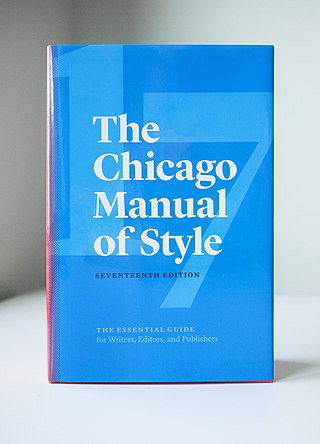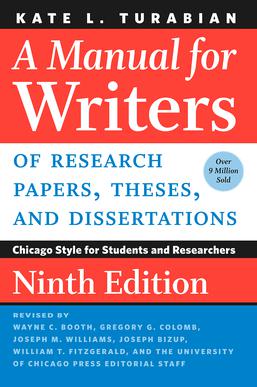Related Research Articles
In ontology, the theory of categories concerns itself with the categories of being: the highest genera or kinds of entities according to Amie Thomasson. To investigate the categories of being, or simply categories, is to determine the most fundamental and the broadest classes of entities. A distinction between such categories, in making the categories or applying them, is called an ontological distinction. Various systems of categories have been proposed, they often include categories for substances, properties, relations, states of affairs or events. A representative question within the theory of categories might articulate itself, for example, in a query like, "Are universals prior to particulars?"

The Chicago Manual of Style is a style guide for American English published since 1906 by the University of Chicago Press. Its 17 editions have prescribed writing and citation styles widely used in publishing.

A citation is a reference to a source. More precisely, a citation is an abbreviated alphanumeric expression embedded in the body of an intellectual work that denotes an entry in the bibliographic references section of the work for the purpose of acknowledging the relevance of the works of others to the topic of discussion at the spot where the citation appears.

Ibid. is an abbreviation for the Latin word ibīdem, meaning "in the same place", commonly used in an endnote, footnote, bibliography citation, or scholarly reference to refer to the source cited in the preceding note or list item. This is similar to Idem, literally meaning "the same", abbreviated id., which is commonly used in legal citation.
A note is a string of text placed at the bottom of a page in a book or document or at the end of a chapter, volume, or the whole text. The note can provide an author's comments on the main text or citations of reference work in support of the text.
OP or Op may refer to:
The abbreviation cf. is used in writing to refer the reader to other material to make a comparison with the topic being discussed. Style guides recommend that "cf." be used only to suggest a comparison, and the words "see" or "vide" be used generally to point to a source of information.
Supra is an academic and legal citation signal used when a writer desires to refer a reader to an earlier-cited authority.
The Latin adverb sic inserted after a quoted word or passage indicates that the quoted matter has been transcribed or translated exactly as found in the source text, complete with any erroneous, archaic, or otherwise nonstandard spelling, punctuation, or grammar. It also applies to any surprising assertion, faulty reasoning, or other matter that might be interpreted as an error of transcription.
Parenthetical referencing is a citation system in which in-text citations are made using parentheses. They are usually accompanied by a full, alphabetized list of citations in an end section, usually titled "references", "reference list", "works cited", or "end-text citations". Parenthetical referencing can be used in lieu of footnote citations.
idem is a Latin term meaning "the same". It is commonly abbreviated as id., which is particularly used in legal citations to denote the previously cited source. It is also used in academic citations to replace the name of a repeated author.
Loc. cit. is a footnote or endnote term used to repeat the title and page number for a given work. Loc. cit. is used in place of ibid. when the reference is not only to the work immediately preceding, but also refers to the same page. Therefore, loc. cit. is never followed by volume or page numbers. Loc. cit. may be contrasted with op. cit., in which reference is made to a work previously cited, but to a different page within that work.
The full stop, period, or full point. is a punctuation mark used for several purposes, most often to mark the end of a declarative sentence.

A Manual for Writers of Research Papers, Theses, and Dissertations is a style guide for writing and formatting research papers, theses, and dissertations and is published by the University of Chicago Press.
Terminal punctuation refers to the punctuation marks used to identify the end of a portion of text. Terminal punctuation marks are also referred to as end marks and stops.

Sidney Mason Stone was a prominent Connecticut architect and builder known for designs of churches, institutional buildings and residences. His creations incorporated Greek Revival, Romanesque, Gothic, Italianate and other styles popular in the 19th century. He served in several civic capacities in the city of New Haven and statewide and as mentor to Yale students prior to the establishment of that university's School of Architecture. He was the father of Harriet Mulford Stone, better known to readers of children's literature as Margaret Sidney, creator of the Five Little Peppers series.

A Wool town is a name given to towns and villages, particularly in Suffolk and north Essex, that were the centre of the woven cloth industry in the Middle Ages.

The values that a person holds may be personal or political depending on whether they are considered in relation to the individual or to society. Apart from moral virtue, examples of personal values include friendship, knowledge, beauty etc. and examples of political values, justice, equality and liberty. This article will outline some current ideas relating to the first group – personal values. It will begin by looking at the kinds of thing that have value and finish with a look at some of the theories that attempt to describe what value is. Reference will be made solely to Western sources although it is recognised that many, if not all, of the values discussed may be universal.
References
- 1 2 3 4 5 6 Fisher Saller, Carol; Harper, Russell David, eds. (2010). "14.31:Op. cit. and loc. cit.". The Chicago Manual of Style (16th ed.). Chicago: Univiversity of Chicago Press. p. 670. ISBN 978-0-226-10420-1.
- ↑ Chicago (2011), "14.28: Short form for titles", pp. 668–669.
- ↑ Marchant; Charles (eds.). "ibidem". Cassell's Latin Dictionary (260th ed.).
- ↑ Chicago (2011), "14.29: ‘Ibid.’", p. 669.
- 1 2 Chicago (2011), "14.30: ‘Idem’", pp. 669–630.